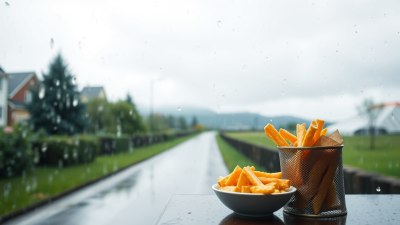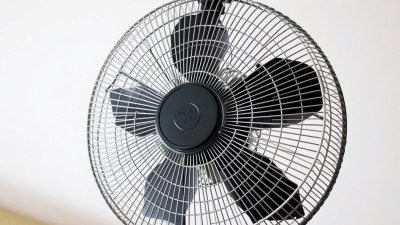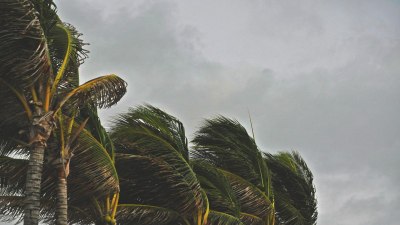What Makes You Crave Snacks More When It’s Dull and Drizzly
Explore why dull, drizzly days trigger snack cravings and how weather, mood, and biology influence eating habits.

Image created with Flux Schnell
Many people notice a particular urge to snack more when the weather is dull and drizzly. This connection between gloomy weather and increased snacking is not merely coincidence; it is rooted in biological, psychological, and environmental factors. Understanding why you crave snacks more during such days can help manage these impulses and make healthier choices. This article delves into the science behind this phenomenon and offers insights into how weather influences appetite and mood.
The Impact of Weather on Mood and Appetite
Weather has a profound effect on human psychology and behavior. On days that are dull and drizzly, the lack of sunlight can lead to changes in brain chemistry, especially related to mood-regulating neurotransmitters like serotonin. Low levels of sunlight reduce serotonin production in the brain, which can lead to feelings of sadness or lethargy. This often results in the desire for comfort, which is commonly found in food, particularly high-calorie snacks.
The link between mood and appetite is well established. When people experience dips in mood, they may eat more to stimulate the production of mood-enhancing chemicals. For example, carbs and sweets lead to the release of serotonin, which increases feelings of well-being temporarily. This creates a cycle: dull weather leads to low serotonin, which leads to cravings, which leads to eating, thereby temporarily boosting mood.
Biological Underpinnings of Weather-Related Cravings
Our bodies react to environmental cues. During gloomy weather, the body’s internal clock, or circadian rhythm, can be disrupted due to limited exposure to natural light. This can affect hormones like melatonin and cortisol that regulate sleep and stress, respectively. Increased melatonin from lack of sunlight can cause sleepiness, while fluctuating cortisol levels can increase stress, both of which can affect appetite.
Cortisol, known as the stress hormone, increases during stressful or low-energy situations, stimulating hunger and cravings for energy-dense foods. These cravings often involve sugary or fatty snacks as the body seeks quick energy. Furthermore, low light exposure may decrease leptin (the hormone signaling fullness) and increase ghrelin (the hormone stimulating hunger), leading to enhanced appetite.
Comfort Eating and Emotional Associations
Food is not only fuel but also comfort. On dull days, people often use snacking as a coping mechanism against emotions such as boredom, sadness, or loneliness. Emotional eating tends to focus on snack foods that are rich in sugar or fat, which can invoke nostalgic feelings or immediate gratification.
The drizzly, monotonous environment promotes stagnation and inactivity, creating more opportunities and time to think about or engage in snacking. This increased downtime can boost the desire for small, frequent food rewards. The act of eating itself releases dopamine, a neurotransmitter tied to pleasure and reward, reinforcing the habit of snacking to elevate mood.
The Role of Habits and Environment
Environmental cues heavily influence eating habits. On dull, rainy days, people tend to stay indoors more, which changes their usual routines. Being inside often comes with proximity to the kitchen or pantry, increasing temptations to snack. Additionally, sedentary behavior increases, which may reduce calorie expenditure but not necessarily the appetite, encouraging snack consumption without balancing energy output.
This shift in routine can also disrupt normal meal patterns, leading to irregular eating times and more snacking occasions. The comfort of a snack becomes intertwined with creating a sense of warmth and coziness, which the dreary weather lacks, thus feeding a cycle of habitual snacking.
Specific Food Cravings on Gloomy Days
When craving snacks on dreary days, people often prefer carbohydrate-rich and sugary foods. These types of snacks not only provide quick energy but also affect serotonin levels, lifting mood temporarily. Common cravings include chocolate, baked goods, chips, and other processed snacks.
Additionally, the temperature might influence the type of snacks desired. Warm beverages like tea, coffee, or hot chocolate accompany cravings for sweet and savory snacks, which creates a multisensory comforting experience. This combination helps counteract the cold and wet weather outside, making snack time more appealing.
Psychological Theories Explaining the Craving Mechanism
Several psychological theories explain why dull and drizzly weather can boost snacking urges. One is the Self-Medication Hypothesis, which suggests individuals consume pleasurable substances, including comfort food, to manage negative emotions. Since gloomy weather is linked to low mood and stress, snacking becomes a form of immediate self-regulation.
Another theory is the Learned Association Model. Past experiences where snack foods made individuals feel better create associations between food and mood improvement. Hence, when faced with gloomy weather, the brain triggers snack cravings as a conditioned response.
How Changes in Activity Levels Affect Cravings
Physical activity tends to decrease on dull and drizzly days, as outdoor exercise may seem less appealing. Reduced movement lowers energy expenditure, yet the body's hunger signals may not adjust immediately. Sometimes, the mismatch between lower calorie needs and the brain’s demand for reward or comfort causes increased snacking without actual energy requirements.
In addition, inactivity can slow metabolism and affect insulin sensitivity, which might further confuse hunger cues and intensify cravings for quick energy sources like sugars. This interplay between reduced activity and snacking can result in a cycle that promotes weight gain and unhealthy eating patterns.
Strategies to Manage Increased Snacking on Dull Days
Understanding these mechanisms helps develop strategies to handle cravings effectively. One approach is increasing exposure to natural or artificial bright light to regulate circadian rhythms and improve mood. Light therapy has been shown to elevate serotonin levels, which may reduce the need to eat for emotional reasons.
Staying active indoors is another key strategy. Exercises such as yoga, aerobic workouts, or even walking inside can help burn calories and stabilize appetite. Planning balanced meals and structured snack times can prevent mindless snacking caused by boredom or emotional triggers.
Keeping healthy snacks available, such as fruits, nuts, or low-calorie options, can satisfy hunger without excessive caloric intake. Hydration also plays a role; sometimes thirst is misinterpreted as hunger, so drinking water regularly can reduce unnecessary snacking.
Practicing mindfulness and emotional awareness is crucial. Recognizing emotional vs physical hunger can help make better food choices. Engaging in hobbies, social interaction, or other fulfilling activities can also distract from food cravings driven by gloomy weather.
Scientific Studies on Weather and Eating Patterns
Several studies have investigated how weather affects eating behavior. Research notes a correlation between reduced sunlight exposure and increased consumption of calorie-dense foods. For example, studies have found that people report higher cravings for sweet and fatty foods during winter or rainy seasons.
A study published in the "Journal of Nutrition" highlighted how mood-related food cravings spike in people susceptible to seasonal affective disorder (SAD) during the winter months, a condition linked to reduced sunlight. This supports the idea that environmental factors like weather strongly influence appetite and food preferences.
Another investigation in the "International Journal of Behavioral Nutrition and Physical Activity" discussed how weather-induced changes in physical activity alter energy balance, suggesting combined effects on eating habits and body weight management.
The Importance of Routine and Structure
Maintaining a consistent daily routine can counteract the influence of dull weather on snacking behaviors. Establishing fixed meal and snack times keeps appetite in check and prevents boredom eating. Scheduling enjoyable indoor activities also reduces idle time that often leads to unnecessary snacking.
Incorporating social interaction, even virtually, provides emotional support and reduces feelings of loneliness, which can trigger emotional eating. Adopting routines that include self-care practices helps regulate mood without relying on food as a primary coping mechanism.
Weather, Sleep, and Snacking Link
Dull and drizzly weather can also impact sleep quality by altering melatonin levels and circadian rhythms. Poor sleep is associated with increased hunger hormones like ghrelin and decreased leptin, making individuals more prone to cravings and overeating.
When tired, the brain seeks quick energy, often leading to snacking on sugary or carb-heavy foods. Ensuring good sleep hygiene during such weather can therefore help control snack cravings and maintain energy balance.
The Role of Hydration on Drizzly Days
Hydration is often overlooked but important when considering weather-related cravings. On cold and wet days, people may drink less water, mistaking thirst for hunger. Mild dehydration can send confusing signals to the brain, exacerbating cravings for snacks.
Maintaining proper hydration can regulate appetite and support metabolic processes, helping to reduce the urge for unnecessary snacking driven by thirst.
Implications for Weight Management
The tendency to snack more during dull and drizzly days can contribute to unwanted weight gain if left unmanaged. Recognizing the cyclical effects of mood, hormone changes, and environmental factors is key for developing personalized strategies to prevent excess calorie intake.
Balancing energy intake with physical activity and making mindful food choices during these times ensures that seasonal or weather-related influences do not derail long-term health goals.
Dull and drizzly weather influences snacking behavior through a complex interplay of biological, psychological, and environmental factors. Reduced sunlight affects serotonin and circadian rhythms, impacting mood and appetite, while stress hormones and emotions drive cravings for comfort foods. Sedentary behavior, changes in routine, and habitual associations further augment the desire to snack. Being aware of these mechanisms allows for better management of cravings through light exposure, physical activity, routine, mindfulness, and dietary choices. This knowledge can help maintain balanced eating habits year-round regardless of the weather.











